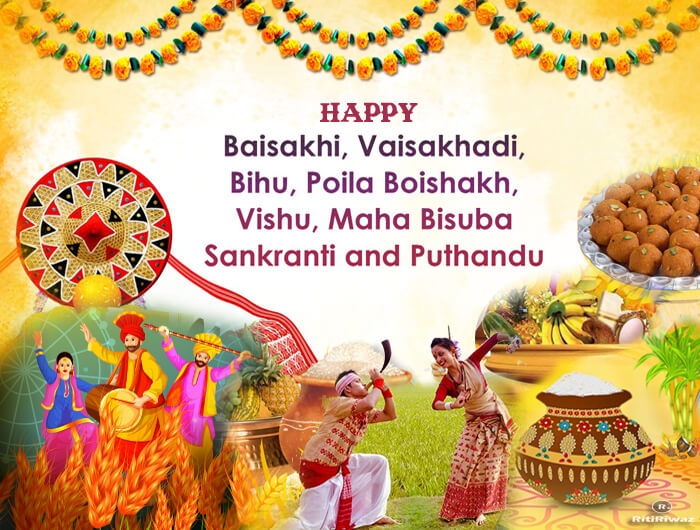Spring Harvest Festivals in India

In Hinduism the month of Chaitra is the beginning of a new year which marks to the end of chilly winters and onset of brighter warm days. Various harvest festivals are celebrated in India with different names and traditions.
India being a agricultural country celebrates every harvest and this is time for harvest of Rabi crops. The time marks the Solar New Year and also celebrating the spring harvest across the country with different names and traditions. The first harvest season in a calendar year – Rabi crops are harvested between the months of April and June. Usually, the seeds for these crops are sown the previous year – between October and December.
As Basant ritu or spring arrives so do the harvest festivals because the Rabi crops are ripe for harvest. Rabi Crops are cut from the farms and sold, its time for farmers to relax and enjoy with good food and music is the main idea behind celebrating the spring harvest festivals. Therefore, many customs woven around these festivals give prominence to food items. The spring harvest is known as Vaishakhi or Baisakhi in Punjab and north India it is also known as Sikh New Year. Pohela Boishakh is also called as Bengali New Year celebrated in Bengal, Vishu is celebrated in Kerala, while Bohag Bihu in Assam. It is also celebrated as Puthandu which is Tamil New Year.
Regional Spring Harvest Festivals in India
Vaisakhi, Vishu, Rongali Bihu, Naba Barsha, Vaisakhadi, Pirappu, Puthandu which are being celebrated in different parts of the country on 13th and 14th April, 2024.
• Baisakhi: Baisakhi, also known as Vaisakhi, Vaishakhi, or Vasakhi, is celebrated with much fanfare in Punjab, Haryana and Chandigarh. Baisakhi is a spring harvest festival for the Sikhs. Baisakhi also commemorates the formation of Khalsa Panth by Guru Gobind Singh in 1699. Baisakhi gets its name from ‘Baisakh’, the first month of the Bikram Sambat Hindu calendar.
In the Hindu tradition, the festival also marks the beginning of the solar new year and is therefore celebrated with the appropriate rituals and ceremonies. This includes visiting temples, bathing in sacred rivers like the Ganges, Jhelum and Kaveri as well as socialising. In Hinduism, Baisakhi is also known by several other names. Given the importance of the festival, the Sikhs strictly follow the customs and traditions. It is their tradition to bathe their holy book – the Granth Sahib – in milk and water on this day. The book is taken out in a procession, amidst fanfare, music, songs, and performances.
• Rongali Bihu: Assam celebrates Bihu thrice in a year but Rongali Bihu is the biggest and most popular. Rongali or the Bohag (spring) Bihu starts on the last day of the Assamese calendar month of Chot, which normally falls on April 13 or 14 annually. Bihu involves the farmer community thanking the almighty for the successful harvest and hoping for abundance in the future. During the period of seven days the entire state is hovered with the songs of love and nature, leaving everything aside.
• Poila Boishakh: Poila Boishakh also known as Pahela Baishakh or Bangla Nababarsha is the first day of lunisolar Bengali Calendar. The festival is celebrated in both Bangladesh and the Indian state of West Bengal, and in Bengali communities in the other Indian states, including Assam, Tripura, Jharkhand and Odisha.
• Mahabishuva Sankranti: On the same day, Odisha celebrates Mahabisuha Sankranti, better known as Pana Sankranti and Oriya New Year. . On this day the sun enters the sidereal Aries or Mesha Rashi. It generally falls on 14/15 April. Maha Vishuva Sankranti is similar to the New Year festivals observed elsewhere in India such as Baisakhi (Punjab), Bihu (Assam), Juir Sheetal (Mithila), Naba Barsha (Bengal), Bisu Parba (Tulu Nadu region in Karnataka), Vishu (Kerala), and Puthandu (Tamil Nadu).
• Puthandu: Puthandu in Tamil Nadu marks the first day of the Tamil New Year. The festival date is set with the solar cycle of the lunisolar Hindu calendar, as the starting day of the Tamil month Chithirai. It falls near 14 April every year on the Gregorian calendar. Tamil people celebrate this day with family and enjoy family time.
• Vishu: Vishu in Kerala marks the completion of the spring equinox. It is observed on the first dayt of the Malayalam month of Medam. But unlike Onam, the other harvest festival, Vishu is a quieter affair, with Lord Vishnu in his Krishna avatar, the presiding deity of the festivities. Malayalis observe the ritual of ‘Vishukanni’. Well, ‘Vishu’ means ‘equal’ in Sanskrit. It marks the period when the sun moves from the southern hemisphere to the northern hemisphere.
• Bikhoti: The Bikhoti Festival of Uttrakhand involves people taking a dip in holy rivers. It is celebrated on the first day of the Vaisakh or the Chaitra month. The traditions of this festival are numerous and captivating and differ from region to region in the Kumaoni region of Uttarakhand.
• Jurshital: In the Mithal region of Bihar and Nepal, the new year is celebrated as Jurshital. This festival takes place on the solar month end of Chaitra . This festival is also related to Harvesting. Mithila people love the nature and take care of nature so this festival express their love and care with nature.






